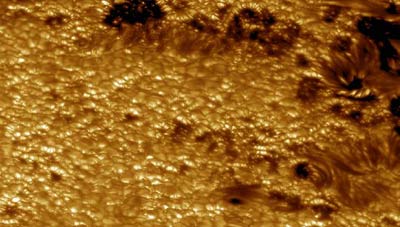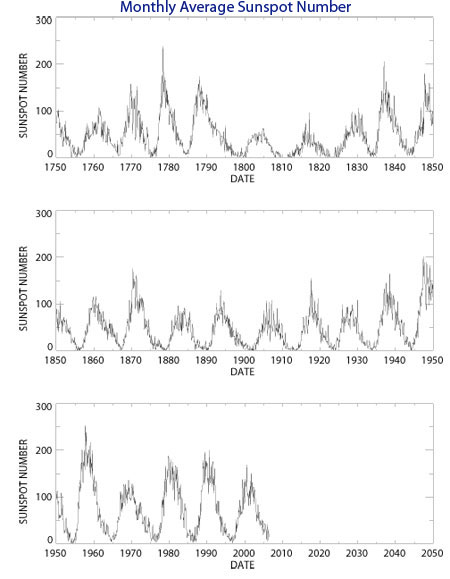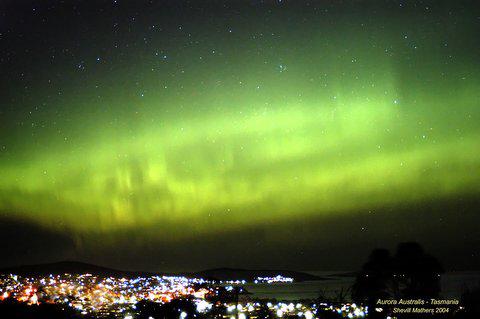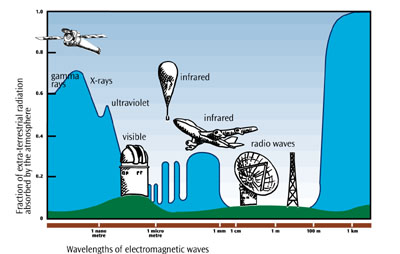Solar Interactions on Earth
Introduction
The Sun is an ever-changing, turbulent star. Sunspots, solar flares and other signs of activity on the Sun are all driven by magnetic fields. However, the physics that underlies solar magnetism is complicated and, in its details, elusive. Emissions from the Sun can directly impact on the near-Earth environment on our atmosphere. Interruptions to power supplies, damage to satellites and disruption to communications may have significant social and financial impact.
Sunspots & the Solar Cycle
When Galileo used a telescope to study the Sun in 1609 he quickly discovered that it was not a perfect object. The surface at times was covered by darker, irregular shaped regions that were termed sunspots. Monitoring individual sunspots and groups, he correctly deduced that the Sun rotates. Sunspots most often forms groups and typically last a few weeks or a month or so. All but the smallest spots have two regions; a darker inner part called the umbra which is surrounded by a lighter region, the penumbra.

The reason that sunspots appear dark is due to the fact that they are cooler then the surrounding photosphere of the Sun. The umbra is about 4,000 K, the penumbra 5,600 K and the granulated surface on the photosphere is at about 6,000 K. Intense magnetic fields of up to 0.4 tesla in the umbras are thought to suppress the convection currents that bring up hot gases from deeper down within the Sun.


Long-term records show that there is a semiregular sunspot cycle. This typically follows an approximately 11 year period or 22 years if the The period 1645-1715 was known as the 'Little Ice Age' on Earth and is remembered in paintings of the Frost Fairs held on the frozen River Thames in London. This period is correlated with a dramatic decline in the number of sunspots, even during the maxima. Now known as the Maunder Minimum, this period of solar inactivity led to cooling of the Earth. due to a slight decrease in solar output. The total amount of energy put out by the Sun varies by a small amount less than one percent over its sunspot cycle. The Sun is brightest at sunspot maximum and least bright at sunspot minimum.

Astronomers now realise that the Sun appears to be not at all unusual in showing magnetic activity - this appears to be ubiquitous among cool dwarf stars (main sequence stars of between 1.2 solar masses and a few tenths of a solar mass).Studies of other solar-type stars have shown that old stars have a different behaviour to young ones in this regard. For old stars like the Sun as it is at present the stars are brightest at starspot maximum, like the Sun. But young solar-type stars like the Sun several billion years ago put out the least radiation during their sunspot maxima.
It is thought that, when the Sun was young, sunspots would have covered at least ten times more of its surface than they do today. The amount of radiation the young Sun delivered to the early Earth could have varied by as much as a few percent over the sunspot cycle. Although these changes would have occurred over only a few years, they may have significantly affected the young Earth's climate.
The Solar Wind & Space Weather
The Sun puts out a huge stream of radiation. This, called the solar wind, consists of particles (electrons, helium and hydrogen atoms and ions, and others), and high-energy X-rays and UV radiation. Flowing from the outer surface of the Sun, it travels across the solar system at 400-700 km.s-1. The wind blasts the inner planets: its action has stripped Mars of much of the atmosphere that planet once had. The Earth has escaped this fate because its magnetosphere, caused by the Earth's magnetic field, diverts most of the solar wind around the planet.
The solar wind rises and falls in strength along with the 11-year sunspot cycle. During periods of greatest activity solar maxima the Sun also undergoes coronal mass ejections (CMEs), each involving about 1012 or 13 kg of solar plasma breaking off out away into space and speeds reaching up to 1000 km.-1. If a CME happens to be directed towards and reach the Earth it can significantly disrupt the Earth's magnetic environment.

Effects of Space Weather on Earth
Solar activity affects at least three kinds of technological systems:
- Satellites
Higher levels of radiation can charge up a satellite's electronics, causing them to fail, through discharge arcs or by building up on insulation. Charged particles can disrupt computer memories. Several satellites have been permanently knocked out by solar activity including in 1997 the AT&T communications satellite Telstar 401. It was the main satellite for CBS, ABC (US) and Fox Broadcasting.
As well, extra solar energy can heat the Earth's atmosphere more than usual, expanding it, and causing extra drag on satellites, pulling them into a lower orbit. To maintain orbit the satellite must expend valuable fuel to push it to a higher orbit though this is normally at the expense of shortened mission life. - Power grids
Changes in the magnetic fields around a conducting network such as a power grid, phone lines or even train tracks will induce surges of current in the conductors, up to hundreds of amperes in magnitude. This can cause vulnerable components, such as transformers, to fail. In 1989 an intense solar storm triggered overloads that triggered a shutdown of the electricity distribution system in Ottawa, Canada, leaving the city blacked out for over eight hours. - Radio communications
The solar wind disrupts radio communications through the way it changes the ionosphere, an electrically-charged layer of the upper atmosphere, 100-500 km in altitude. For some applications (e.g. over-the-horizon radar), the ionosphere is used as a mirror. If it is disrupted by 'space weather', it distorts the reflected signal. The disrupted ionosphere can also affects signals to and from satellites: GPS navigation signals can lose accuracy or even drop out altogether.
In Australia, the IPS Radio and Space Services forecasts space weather, models its effects on radio propagation, and offers various services to those who may be affected.
Aurorae are also caused by solar interactions with the Earth's upper atmosphere. Charged particles in the solar wind and from solar flares get channeled by the Earth's magnetic field towards the polar regions. The interactions with molecules and atoms in the ionosphere produce distinctive ever changing auroral glows, typically green and red, which are visible in the night sky.


Protecting the Earth
The Earth's atmosphere and its magnetic field both help to protect life at the Earth's surface from the radiation in space.
In the late 1950s, early experiments in exploring space found that the Earth is ringed by regions where its magnetic field has trapped high concentrations of charged particles. These regions are the Van Allen belts. Other planets have them too. Jupiter's are the strongest, and here you can see pictures of them made by CSIRO's Australia Telescope: in 2D, and as 3D mpeg movies.
Atmospheric 'Windows'
Most harmful photon radiation from the Sun is absorbed by the near-Earth atmosphere. Different wavelengths of electromagnetic radiation vary in the degree to which they are absorbed, as the simple picture below shows.

These various atmospheric 'windows' also determine which kinds of astronomy can be done from the ground, and which have to be done from space. For a vast range of radio wavelengths, for instance, the atmosphere is completely transparent. But to do X-ray or gamma-ray astronomy it is essential that the instruments fly high above the atmosphere, on satellites.
The Earth's atmosphere was not always as protective as it is today: its density and composition have changed significantly over time.
By learning more about the atmospheres of the other planets in the Solar System we can better understand basic atmospheric processes such as the greenhouse effect, aerosol and cloud physics, and atmospheric chemistry.
